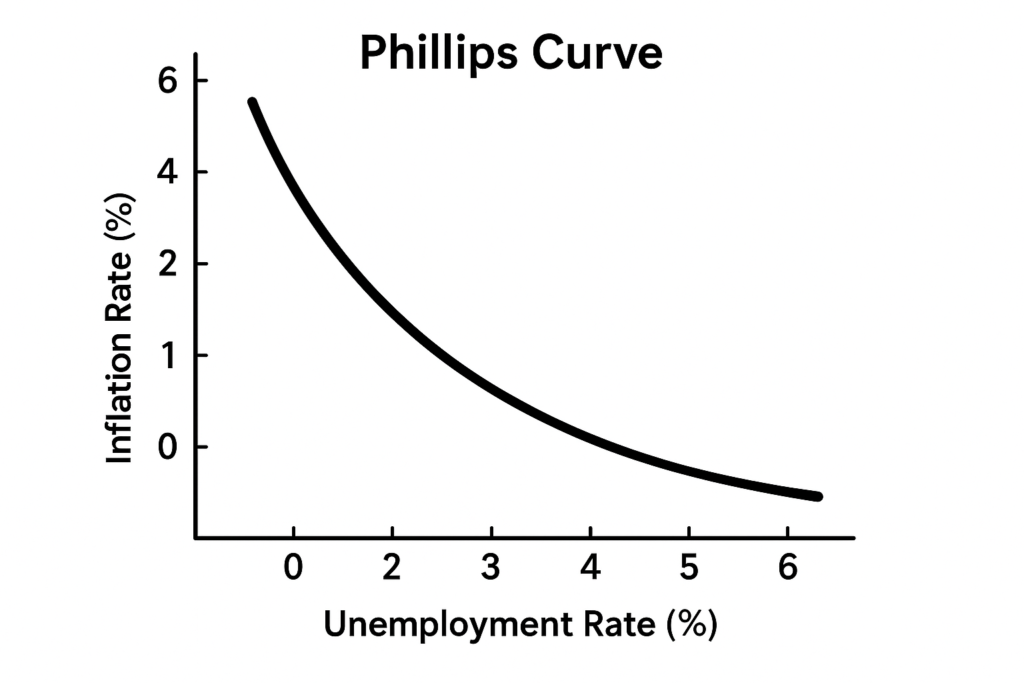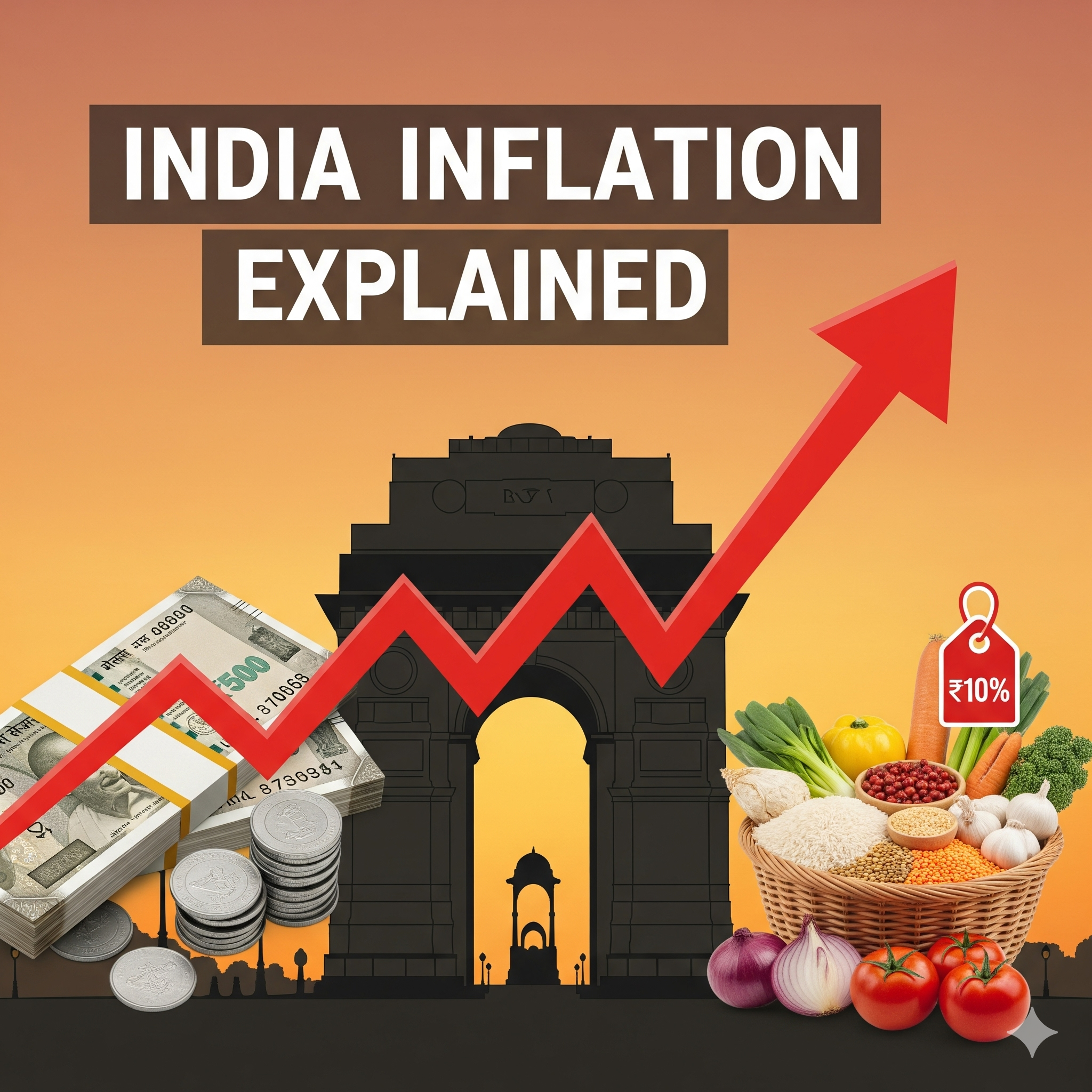Key Highlights
- Current Status: India’s CPI inflation stands at 2.07% (August 2025), well within RBI’s 4% ±2% target band
- Policy Framework: RBI maintains flexible inflation targeting with 4% target since 2016, recently retained for 2021-2026 period
- Global Context: India outperforms global inflation trends, with world inflation projected at 4.2% in 2025
- Transmission Mechanism: Repo rate cuts of 100 basis points since February 2025 support growth while maintaining price stability
- Structural Challenges: Food and fuel price volatility remain key concerns despite overall inflation moderation
Understanding Inflation: Core Concepts

Inflation represents a sustained increase in the general price level of goods and services across an economy over time. Unlike temporary price fluctuations of individual commodities, inflation reflects broad-based price movements that erode purchasing power and affect economic stability.
Key Features of Inflation
Continuity and Persistence: True inflation involves sustained price increases rather than one-time adjustments. The phenomenon must persist across multiple periods to qualify as genuine inflationary pressure.
Basket-Based Measurement: Inflation calculations rely on representative baskets of goods and services that reflect typical consumption patterns. In India, both Consumer Price Index (CPI) and Wholesale Price Index (WPI) serve as primary inflation indicators. mospi
Monetary Linkage: Inflation connects closely with money supply growth and purchasing power dynamics. When money supply expands faster than economic output, inflationary pressures typically emerge.
Types of Inflation: A Comprehensive Classification
Rate-Based Classification
Creeping Inflation: Annual price increases of 1-3%, considered healthy for economic growth. This moderate inflation encourages spending and investment while preserving purchasing power.
Walking Inflation: Price rises of 3-10% annually, indicating stronger economic activity but requiring careful monetary management to prevent acceleration.
Running Inflation: Annual increases of 10-20%, creating significant economic distortions and requiring aggressive policy intervention.
Galloping Inflation: Price increases exceeding 20% annually, threatening economic stability and social welfare.
Hyperinflation: Extreme price increases often exceeding 50% monthly, devastating economies and requiring fundamental structural reforms
Cause-Based Classification
Demand-Pull Inflation: Results from excessive aggregate demand relative to supply capacity. India experienced this during post-COVID recovery periods when pent-up demand exceeded production capabilities.
Cost-Push Inflation: Emerges from rising input costs, including wages, raw materials, or energy prices. Global oil price shocks significantly impact India’s inflation through this mechanism.
Structural Inflation: Reflects supply-side bottlenecks and institutional inefficiencies. India’s agricultural supply chain constraints and infrastructure gaps contribute to this type.
Imported Inflation: Occurs when rising global commodity prices affect domestic price levels. India’s energy import dependence makes it particularly vulnerable to external price shocks.
Monetary Inflation: Results from excessive money supply growth relative to economic output, often following accommodative monetary policies.
Current Indian Inflation Landscape: 2025 Analysis
Recent Performance Indicators
India’s inflation performance in 2025 demonstrates remarkable stability compared to global trends. CPI inflation reached 2.07% in August 2025, significantly lower than the 4% target, while WPI inflation registered 0.52%.
Food Inflation Dynamics: Food price deflation of -0.69% in August 2025 provided substantial relief to consumers, particularly in rural areas where food expenses constitute larger budget shares. mospi
Regional Variations: Rural CPI inflation (1.18%) slightly exceeded urban levels (1.69%), reflecting differential exposure to food price movements and varying consumption patterns.
Component Analysis: Core inflation excluding volatile food and fuel components remained subdued, indicating well-anchored inflation expectations and effective monetary policy transmission pib
The Phillips Curve Paradox in Indian Context

The traditional Phillips Curve suggests an inverse relationship between inflation and unemployment, but India’s experience challenges this conventional wisdom.
Empirical Evidence from Indian Studies
Recent research spanning 1991-2021 reveals a complex relationship between inflation and unemployment in India that often contradicts Phillips Curve predictions.
Positive Correlation: Multiple studies find positive rather than inverse relationships between inflation and unemployment, suggesting structural factors override traditional trade-offs. thc.edu
Period-Specific Variations: During 2005-2008, traditional inverse relationships held, but broader timeframes show negligible or positive correlations.
Policy Implications: The absence of clear Phillips Curve relationships suggests Indian policymakers cannot rely on inflation-unemployment trade-offs for policy design.
Theoretical Explanations
Supply-Side Dominance: India’s inflation often stems from supply constraints rather than demand pressures, weakening traditional Phillips relationships.
Structural Unemployment: High levels of structural and frictional unemployment may insulate employment from monetary policy changes.
Informal Economy Impact: Large informal sector employment may not respond to monetary policy in ways captured by traditional Phillips Curve models.
RBI’s Monetary Policy Framework: Institutional Foundations

Flexible Inflation Targeting Architecture
India adopted flexible inflation targeting (FIT) in 2016 through RBI Act amendments, establishing a formal framework for price stability as the primary monetary policy objective.
Target Specification: The 4% inflation target with ±2% tolerance band balances price stability with growth objectives, accommodating supply shocks while maintaining credibility. prsindia
Institutional Structure: The six-member Monetary Policy Committee (MPC) includes three RBI officials and three government nominees, ensuring balanced decision-making.
Review Mechanism: The framework undergoes mandatory five-year reviews, with the current framework extended through March 2026.
Policy Transmission Mechanisms
Interest Rate Channel: Repo rate changes influence bank lending rates, affecting borrowing costs for consumers and businesses.
Credit Channel: Monetary policy impacts bank lending capacity and willingness, affecting credit availability and economic activity.
Asset Price Channel: Policy changes influence equity markets, bond yields, and real estate prices, affecting wealth and investment decisions.
Exchange Rate Channel: Interest rate differentials impact currency values, affecting import costs and export competitiveness.
Global Inflation Context and Comparative Analysis
International Trends 2025
Global inflation patterns in 2025 reflect diverse regional experiences, with advanced economies generally achieving better price stability than emerging markets. adb
Developed Economy Performance: Major economies like the US face persistent inflation above target levels, while India maintains better control.
Regional Variations: South Asian inflation averages 4.4% in 2025, with India’s performance significantly better than regional peers.
Supply Chain Impacts: Global supply disruptions from geopolitical tensions continue affecting commodity prices and inflation dynamics worldwide.
India’s Relative Outperformance
Structural Factors: India’s diversified economy and improved policy frameworks contribute to inflation resilience compared to commodity-dependent economies.
Policy Effectiveness: Coordinated fiscal and monetary policies have successfully balanced growth support with price stability. pib
External Vulnerability: Despite outperformance, India remains exposed to global commodity price shocks, particularly energy imports.
Challenges in Inflation Measurement and Management
Measurement Complexities
Index Limitations: Both CPI and WPI face challenges in capturing quality improvements, new products, and changing consumption patterns.
Base Year Effects: Periodic base year revisions can affect inflation calculations and historical comparisons.
Regional Heterogeneity: National inflation figures may not reflect significant regional price variations across India’s diverse economy.
Policy Implementation Challenges
Transmission Lags: Monetary policy effects take 6-18 months to fully manifest, complicating real-time policy adjustments.
Supply-Side Constraints: Structural bottlenecks in agriculture and infrastructure limit monetary policy effectiveness against supply-driven inflation.
Political Economy Pressures: Food and fuel price sensitivities create political pressures for subsidies and price controls that may distort market signals.
Future Outlook and Strategic Considerations
Near-Term Prospects 2025-2026
India’s inflation trajectory appears well-positioned for continued stability, with structural improvements supporting the outlook.
Favorable Base Effects: Low inflation in 2025 creates favorable statistical bases for 2026 comparisons.
Monsoon Dependency: Agricultural production remains vulnerable to weather patterns, affecting food inflation prospects.
Global Integration: Increasing trade integration exposes India to external price shocks requiring vigilant monitoring.
Long-Term Structural Reforms
Agricultural Modernization: Improving supply chain efficiency and reducing post-harvest losses can sustainably moderate food inflation.
Energy Diversification: Reducing dependence on energy imports through renewable development can limit external vulnerability.
Financial Market Development: Deeper capital markets can improve monetary policy transmission and economic resilience.
Conclusion: Navigating India’s Inflation Trajectory
India’s inflation management in 2025 demonstrates the maturation of institutional frameworks and policy coordination. The successful maintenance of price stability within target ranges while supporting economic growth reflects improved understanding of inflation dynamics and effective policy implementation.
The challenges ahead require continued vigilance against supply-side vulnerabilities, particularly food and energy prices, while maintaining the flexibility to respond to external shocks. The ongoing review of the inflation targeting framework provides opportunities to refine approaches based on accumulated experience and evolving economic structures.
As India continues its development journey, maintaining price stability while supporting growth remains a delicate balance. The lessons from recent years suggest that institutional frameworks, policy coordination, and adaptive responses to structural changes will determine future success in inflation management.









+ There are no comments
Add yours